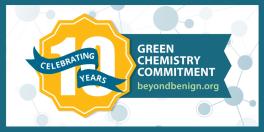A promise to a sustainable future: 10 years of the Green Chemistry Commitment at Beyond Benign

Summary
Green chemistry education is a fundamental tool for the achievement of a sustainable future at the molecular level. It allows the development of a scientific workforce and knowledgeable citizenry with the skills to choose, assess, and further design more benign processes for human health and the environment. In 2007, Dr Amy Cannon and Dr John Warner co-founded a non-profit organization known as Beyond Benign to empower educators dedicated to creating a systemic, long-lasting, and meaningful change in education through green chemistry. The Green Chemistry Commitment (GCC) was launched in 2013 with 13 participating institutions as Beyond Benign's higher education program to support universities, colleges, schools, and centers worldwide to incorporate green chemistry in their curricula. The Commitment is a signal of intent provided by higher institutions to begin, continue, or optimize their unique green chemistry journeys, thus preparing the future workforce to address our societal and environmental challenges. Over 150 institutions in more than 15 countries are now part of this growing program, with the ultimate goal of advocating for a diverse, accessible, inspiring, and empowered green chemistry community capable of providing the transformation needed for a sustainable future.




